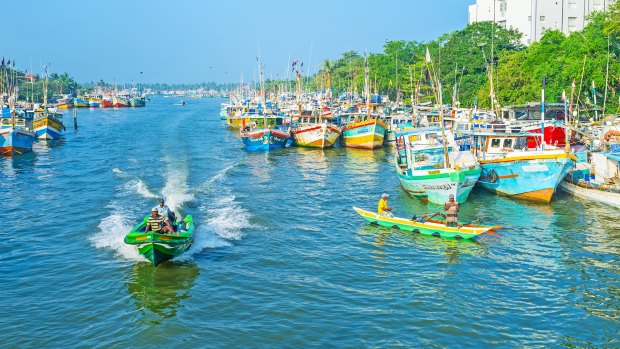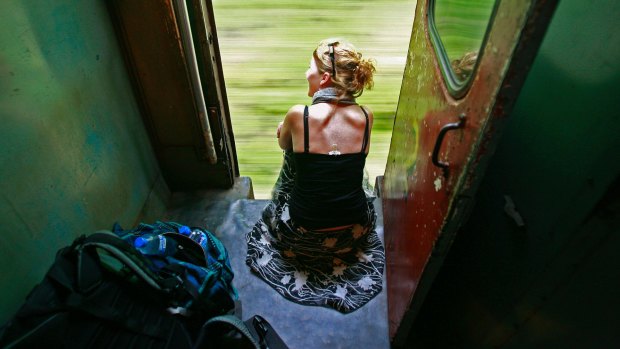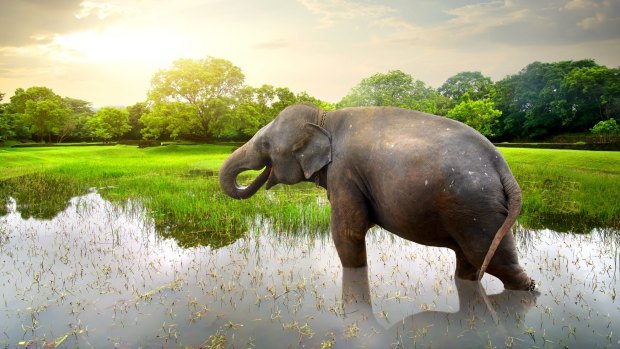By Angela Saurine

Boats on Negombo lagoon.
After a 30-year civil war and the devastation of the 2004 tsunami, Sri Lanka has well and truly bounced back. In recent years, the island nation's historical and cultural attractions, white sand beaches and moreish food have seen it regularly featured on lists of the world's hottest travel destinations. More than 2 million people visited Sri Lanka in 2016 – four times more than before the tsunami. And, as with any country, the best way to experience it is as the locals do. Sure, brave the crowds and tick off the main tourist sights, including the UNESCO World Heritage-listed Sigiriya Rock Fortress and the ancient capital, Polonnaruwa. But also take the time to dine in family homes, catch public transport and visit markets to get to know the real Sri Lanka.
RIDE THE RAILS
First-class travel may be what most travellers aspire to, but where's the fun in that? In Sri Lanka, it's way more interesting to book a third-class train ticket and hang out with commuters. We sit with our legs hanging out the door, long grass lashing against the soles of our feet, listening to the sound of the carriage creaking and clanging as we pass green terraced tea plantations en route from the ancient kingdom of Kandy to the hill town of Nuwara Eliya, 1500 metres above sea level. Hawkers walk up and down the carriage calling for passengers to buy snacks such as vade, or fried dahl. For part of the journey, a group of playful young men on their way to a picnic at a waterfall gather in the entranceway singing upbeat Sri Lankan love songs, banging the walls with their hands and tapping coins in time with the beat.

A tourist looks out the train on the way to Galle.
CANAL LIFE
Floating along the Dutch canal in Negombo, 40 kilometres north of Sri Lanka's largest city Colombo, is a wonderful way to see traditional life. Women wash clothes along the banks, children bathe and shirtless fishermen repair their nets. A ferry barge carries large bags of vegetables across the canal. We pass skinny cows grazing, see water monitors swimming beside our boat and spot egrets, cormorants and other birds, including a blue-tailed bee-eater, white-breasted kingfisher and parakeets. We pull ashore to meet a "toddy tapper", Anthony, who shows us how to make the coconut toddy, or arrack, he drinks with friends in a small, thatched roof hut on his property, as is common in Sri Lanka. He slings a jug over his shoulder and climbs a coconut tree, walking along a rope from one to another to extract sap from unopened flowers. The sugar ferments naturally in the tree in the heat and becomes pure alcohol, our G Adventures guide Rihas Serendib explains. After he strains out the bees, Anthony pours the toddy into cups and invites us to taste it. Perhaps unsurprisingly, I find it has a strong, tangy flavour, with a woody aftertaste.
MEANDER MARKETS

Crops have to be protected from elephants.
One of the best ways to get to know a place is by visiting markets, and Negombo Fish Market does not disappoint. Our local guide, Bernard, has been a merchant here all his life, and even appeared on the TV show Rick Stein's Far Eastern Odyssey when the British chef filmed in Sri Lanka. He leads us around the stalls and points out the wide range of seafood, including blue swimmer crabs, prawns, barracuda, parrotfish, swordfish and squid. Down by the ocean, women gut and skin fish caught by fishermen in outrigger canoes, salt them and place them in drums. The fish are then washed and spread out along the beach to dry for three to four days before being transported to inland towns to be sold.
TRY TRADITIONAL MEDICINE
Sri Lankans have been practising traditional medicine, known as Ayurveda, for centuries. Highland Spice Garden at Matale, about 20 kilometres north of Kandy, is a great place to learn about alternatives to western pharmaceuticals. We discover that cinnamon leaf can be turned into an oil and rubbed on skin to improve circulation, needra can help with insomnia, aloe vera prevents wrinkles, green oil cures hangovers, and kamayogi acts as a natural Viagra. We are also introduced to a natural hair remover, which consists of aloe vera, sandalwood and turmeric, and sip ashokarishta, colloquially known as "lady tonic", which is said to ease PMS. Naturally, there is a store where you can stock up on creams and other Ayurvedic products on the way out.
DINE IN FAMILY HOMES
Throughout Sri Lanka, entrepreneurial families have set up restaurants at the front of their homes, giving tourists the chance to enjoy an authentic dining experience. Usually, they are named after the man of the house. At Rohan's Place in Negombo, the jovial owner happily high-fives guests and chats about the cricket while his wife cooks up a feast, which includes noodles and grilled prawns with rice. He seems genuinely excited to have customers from around the world. Another great find is Duminda Hotel, just across the road from Thilanka Resort and Spa, in Dambulla. Here, we sit outside at night and try a Sri Lankan favourite – egg hopper (a bowl-shaped pancake made from rice batter and coconut milk) with kottu roti (chopped bread with meat, vegetables and spices).
TEA TIME
Tea was introduced to Sri Lanka by British expat James Taylor in the 1860s, and the country now produces nearly a third of the world's supply. The town of Nuwara Eliya, known as "Little England", was once a retreat for the British and Scottish pioneers of the industry. The Tudor-style Grand Hotel, which was home to governor Sir Edward Barnes in the 1800s, offers visitors the chance to sample colonial life, with high tea served every afternoon either on the lawn or in the lounge. We also wander among the fields at Blue Field Tea at nearby Mount Harrow, and learn how to pick tea from the women who work there. We are shocked to discover that, despite their small frames, they pick up to 18 kilograms a day.
SAMPLE RURAL LIVING
Sri Lanka is increasingly becoming known for its luxury lodges and resorts, but Gangadhara Eco Lodge provides the chance to stay in the middle of a rural village at Kuda Oya, in the country's south, and give back to the community. The tented camp was built by G Adventures five years ago, and provides employment to people from 20 local families who grow vegetables for guests' meals, wash linen and work in the kitchen. With his two dogs by his side, manager Chandana happily leads us on a guided walk along the Kirindi-Oya stream, past peanut farms and houses. His pet guinea fowl, whose mate was sadly killed by a hawk, also follows for part of the way. Chandana says the villagers are mostly farmers who work from morning to night and are very poor, but healthy. They lead a happy, simple life, he says. We see how crops are protected from elephants with barbed wire and rusty empty tins, and hear fireworks being set off in the distance to scare them away. After dinner that night we sit around the campfire, sing and play drums with Chandana, our driver and guide and pretend, just for a moment, we don't have to return home.
TRIP NOTES
MORE
FLY
Singapore Airlines flies to Colombo via Singapore from Sydney, Melbourne, Brisbane, Adelaide and Perth. See singaporeair.com
TOUR
G Adventures' small group 14-day Sri Lanka Encompassed tour from Negombo to Colombo starts from $2099 a person. The price includes 12 nights' hotel accommodation, one night in a tented camp, most tours, local guides, all breakfasts, one lunch and one dinner. Valid for travel until December 31, 2017. See gadventures.com.au/Sri-Lanka
WHEN
Due to its proximity to the equator, Sri Lanka enjoys warm temperatures year-round, with two monsoon seasons in the south-west from May to August and the north-east from October until late December. The best time to visit the whole island is from January to April.
Angela Saurine travelled as a guest of G Adventures.
FIVE MORE THINGS TO DO IN SRI LANKA
VISIT ANURADHAPURA
Explore the stupas and temples at the UNESCO World Heritage-listed sacred city, Anuradhapura, which was built around a cutting of the bodhi tree under which Buddha gained enlightenment in India.
BEACH BLISS
Learn to surf, snorkel or hang out and relax at one of Sri Lanka's many beautiful beaches, such as the hippie-haven Hikkaduwa or Bentota Beach on the south-west coast.
WILDLIFE SAFARI
Search for leopards, elephants, monkeys, spotted deer, wild boar and crocodiles on a jeep safari in Yala National Park, in south-east Sri Lanka.
ROOFTOP COCKTAILS
Soak up the view over Colombo while sipping on a martini at the sophisticated Sky Lounge open-air bar atop the Kingsbury Hotel.
TSUNAMI MEMORIAL
Remember the 1700 people killed on the overcrowded Ocean Queen train when a tsunami hit Sri Lanka in 2004. The graphic memorial is at Peraliya, near Hikkaduwa.
Sign up for the Traveller Deals newsletter
Get exclusive travel deals delivered straight to your inbox. Sign up now.